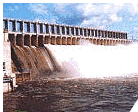

 |
 |
||||||
Successfully used as a textbook by major universities |
Title: Open Channel Hydraulics This book is primarily a text for graduate or undergraduate students in civil and agricultural engineering and hydrologic science. Extensively Revised from the original text. |
|
DESCRIPTION
Open Channel Hydraulics covers the fundamental concepts of open channel hydraulics and mixing and dispersion in open channels. It also provides an introduction for solving gradually varied steady and unsteady flow problems using industry standard models such as HEC-RAS. The book also discusses the design of stable channels from the viewpoints of both the geoscience and engineering communities. The book is not intended to be a comprehensive treatment of the subject as the first edition was; rather it is intended to be a text for upper division and graduate courses on the subject; and lead to additional references that treat specialized topics. At the end of each chapter are a series of problems for students to solve.
Chapter 1 explains the types of flow encountered in open channels are classified with respect to time, space, viscosity, density, and gravity. In Chapter 2, the application of the law of conservation of energy to open-channel flows is discussed. Chapter 3 considers the application of the law of conservation of momentum to open-channel flow. Chapter 4 defines uniform flow and develops the Chezy and Manning equations for uniform flow. Both theoretical and applied methods of estimating the resistance coefficients used in these equations are then discussed. Chapter 5 primarily emphases techniques of computing the normal depth of flow in open channels. Chapter 6 considers the theory and analysis of gradually and spatially varied flow. In Chapter 7, the design of lined, unlined, and grass-lined channels is considered, and design procedures for each type of channel are discussed and demonstrated. The transport processes known as turbulent diffusion and dispersion are discussed in Chapter 8. In Chapter 9, the subject of gradually varied unsteady flow is treated: in the initial section, both hydraulic and hydrologic methodologies are discussed. Chapter 10 discusses the design, construction, and use of physical models to examine open-channel flow phenomena. Among the types of models considered are geometrically distorted and undistorted, fixed and movable bed, and ice.
TABLE OF CONTENTS
CHAPTER 1 - CONCEPTS OF FLUID FLOW 1.1. INTRODUCTION 1.2. DEFINITIONS 1.3. GOVERNING EQUATIONS 1.4. THEORETICAL CONCEPTS 1.5. SIMILARITY AND PHYSICAL MODELS 1.6. QUANTIFYING UNCERTAINTY 1.7. BIBLIOGRAPHY 1.8. PROBLEMS CHAPTER 2 - ENERGY PRINCIPLE 2.1. DEFINITION OF SPECIFIC ENERGY 2.2. SUBCRITICAL, CRITICAL AND SUPERCRITICAL FLOW 2.3. ACCESSIBILITY AND CONTROLS 2.4. APPLICATION OF THE ENERGY PRINCIPLE TO PRACTICE 2.5. BIBLIOGRAPHY 2.6. PROBLEMS CHAPTER 3 - THE MOMENTUM PRINCIPLE 3.1. DEFINITION OF SPECIFIC MOMENTUM 3.2. THE HYDRAULIC JUMP 3.3 HYDRAULIC JUMPS AT DENSITY INTERFACES 3.4. APPLICATION OF THE MOMENTUM PRINCIPLE TO PRACTICE 3.5. BIBLIOGRAPHY 3.6. PROBLEMS CHAPTER 4 - DEVELOPMENT OF UNIFORM FLOW CONCEPTS 4.1. ESTABLISHMENT OF UNIFORM FLOW 4.2. THE CHEZY AND MANNING EQUATIONS 4.3. RESISTANCE COEFFICIENT ESTIMATION 4.4. BIBLIOGRAPHY CHAPTER 5 - COMPUTATION OF UNIFORM FLOW 5.1. CALCULATION OF NORMAL DEPTH AND VELOCITY 5.2. NORMAL AND CRITICAL SLOPES 5.3. CHANNELS OF COMPOSITE ROUGHNESS 5.4. APPLICATION OF UNIFORM FLOW CONCEPTS TO PRACTICE 5.5. BIBLIOGRAPHY 5.6. PROBLEMS CHAPTER 6 - THEORY AND ANALYSIS OF GRADUALLY AND SPATIALLY VARIED FLOW 6.1. BASIC ASSUMPTIONS AND THE EQUATION OF GRADUALLY VARIED FLOW 6.2. CHARACTERISTICS AND CLASSIFICATION OF GRADUALLY VARIED FLOW PROFILES 6.3. COMPUTATION OF GRADUALLY VARIED FLOW
|
6.4. SPATIALLY VARIED FLOW 6.5. APPLICATION TO PRACTICE 6.6 BIBLIOGRAPHY 6.7 PROBLEMS CHAPTER 7 - DESIGN OF CHANNELS 7.1. INTRODUCTION 7.2. DESIGN OF LINED CHANNELS 7.3. DESIGN OF STABLE, UNLINED, EARTHEN CHANNELS: A GENERAL TRACTIVE FORCE DESIGN METHODOLOGY 7.4. DESIGN OF CHANNELS LINED WITH GRASS 7.5. BIBLIOGRAPHY 7.6. PROBLEMS CHAPTER 8 - TURBULENT DIFFUSION AND DISPERSION IN OPEN CHANNEL FLOW 8.1. INTRODUCTION 8.2. GOVERNING EQUATIONS 8.3. VERTICAL AND TRANSVERSE TURBULENT DIFFUSION AND LONGITUDINAL DISPERSION 8.4. NUMERICAL DISPERSION 8.5. VERTICAL, TURBULENT DIFFUSION IN A CONTINUOUSLY STRATIFIED ENVIRONMENT 8.6. BIBLIOGRAPHY 8.7. PROBLEMS CHAPTER 9 - UNSTEADY FLOW: HYDROLOGIC AND HYDRAULIC APPROACHES 9.1. INTRODUCTION 9.2. HYDROLOGIC APPROACHES 9.3. HYDRAULIC APPROACHES 9.4. BOUNDARY AND INITIAL CONDITIONS 9.5. CALIBRATION AND VERIFICATION 9.6. BIBLIOGRAPHY 9.7. PROBLEMS CHAPTER 10 - HYDRAULIC MODELS 10.1. INTRODUCTION 10.2. FIXED-BED RIVER OR CHANNEL MODELS 10.3. MOVABLE-BED MODELS 10.4. MODEL MATERIALS AND CONSTRUCTION 10.5. PHYSICAL MODEL CALIBRATION AND VERIFICATION 10.6. SPECIAL-PURPOSE MODELS 10.7. BIBLIOGRAPHY 10.8. PROBLEMS Appendix 1 Appendix 2 SUBJECT INDEX AUTHOR INDEX |
© Copyright 2021. Water Resource Publications, LLC. All
rights reserved.
Colorado, USATelephone: 720-873-0171 / Fax: 720-873-0173
E-mail:
